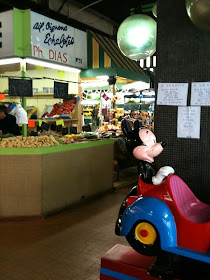 In the foreground, a building is being brought to the ground, naked except for a forlorn sign offering bargains on long since departed furniture stock. Behind, the giant Tour Courcellor is getting dressed up for a new decade. A curious contrast, but one which reminds us of a simple fact. In all construction there is first destruction.
In the foreground, a building is being brought to the ground, naked except for a forlorn sign offering bargains on long since departed furniture stock. Behind, the giant Tour Courcellor is getting dressed up for a new decade. A curious contrast, but one which reminds us of a simple fact. In all construction there is first destruction.The Tour Courcellor in Levallois has been an imposing hulk alongside the railway lines running into Saint Lazare since the 1960s. A remnant of the time when the town was Communist-led, it's clothes, dripping with asbestos, were no longer in vogue and are now being replaced.

Off comes the concrete and cladding, on goes shiny blue glass. At its feet, the smaller neighbours had no offer of a new wardrobe, and will simply be replaced by brighter, lighter units, clearly contemporary but not built to last.
































